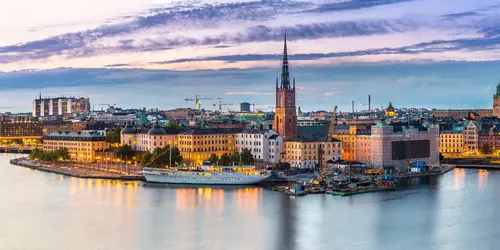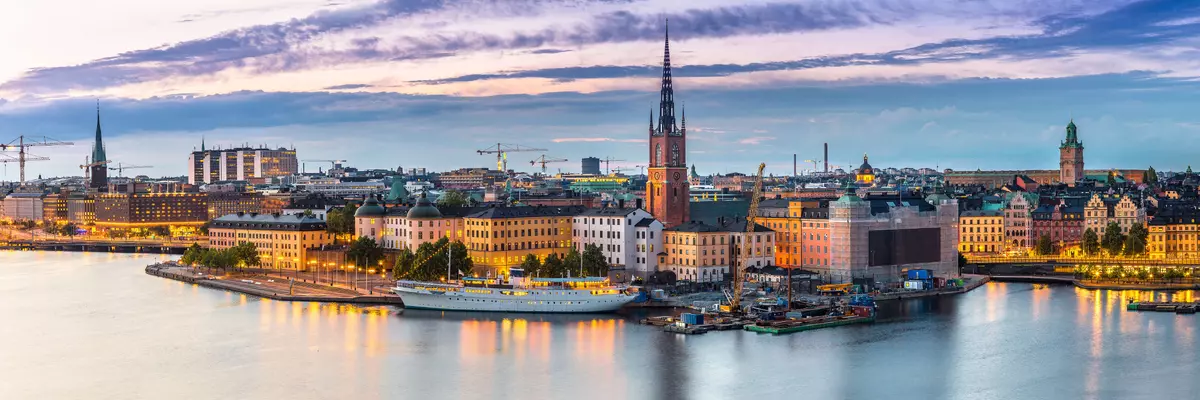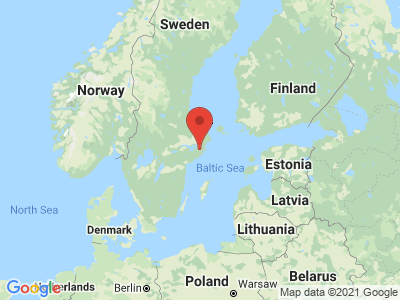Climate Table Stockholm
Jan | Feb | Mar | Apr | May | Jun | Jul | Aug | Sep | Oct | Nov | Dec | |
|---|---|---|---|---|---|---|---|---|---|---|---|---|
| Max. Temperature | -1° | -1° | 3° | 8° | 14° | 19° | 22° | 20° | 15° | 9° | 5° | 2° |
| Min. Temperature | -5° | -5° | -4° | 1° | 6° | 11° | 14° | 13° | 9° | 5° | 1° | -2° |
| Sun Hours | 1 | 2 | 5 | 7 | 9 | 10 | 9 | 7 | 6 | 3 | 1 | 1 |
| Water Temperature | 3° | 1° | 1° | 2° | 5° | 10° | 15° | 15° | 13° | 10° | 7° | 4° |
| Rain Days | 10 | 7 | 6 | 7 | 7 | 8 | 9 | 10 | 9 | 9 | 10 | 11 |
The climate year of Stockholm
Stockholm, also called "the floating city", stretches over 14 islands connected by 57 bridges. Stockholm's special location, between Lake Mälaren and the Baltic Sea, means that water is omnipresent in Scandinavia's largest city. Off the coast of Stockholm lies the Stockholm Archipelago, which is home to some 30,000 islands. The location by the sea also affects the climate in Stockholm. Thus, relatively high precipitation can be expected in the Swedish capital throughout the year. In addition, the temperatures in winter do not drop as much as the northern location might suggest.
General information about Stockholm
Gamla Stan, Stockholm's old town, is the heart of Stockholm. Before the city grew from here, it was the real Stockholm for many centuries. The old town is characterized by narrow streets, crooked houses, small cafes, craft stores, souvenir stores and quite a few sights. Important buildings like the Royal Castle ("Kungliga Slottet") and the Cathedral Church ("Storkyrkan"), where Crown Princess Victoria married her Daniel in 2010, can be found here. In addition, probably Stockholm's most famous tourist attraction takes place at the Royal Palace - the traditional changing of the guard. During the summer months (June-August), this can be observed Monday through Saturday at 12:15 pm and Sunday at 1:15 pm. In the winter months, however, it can only be seen on Wednesdays and Saturdays at 12:15.
The balance between city and nature is characteristic for Stockholm. Thus, on the island of Djurgården, located in the center of Stockholm, is the Royal Zoo ("Kungliga Djurgården") - the only national park inside a European capital. Therefore, the island is also called the green lungs of Stockholm. Besides the zoo, there are many other attractions here, such as the world's first open-air museum Skansen or the Vasa Museum, which exhibits the almost completely preserved warship Vasa, sunk on its maiden voyage in 1628.
Tourism Stockholm
Stockholm is strongly influenced by the continental climate. This results in summers that are sunny and warm and winters with dry cold. The most popular time for a city trip to Stockholm are the summer months from June to September. Here the sunshine hours reach their peak and the sun shines nine to ten hours a day. This is the ideal time to go to one of the more than 30 beach resorts, to go swimming or to go on other excursions. Nevertheless, it can rain at any time, so you should be prepared for it. In addition, the days are particularly long in the summer months, as the sun only sets for a few hours at midsummer.
If you prefer the cold winter with its snow, you should travel to Stockholm during the winter months. Snow is guaranteed and in contrast to the damp cold in Germany, the dry cold of Stockholm is much more pleasant. From September onwards, the days become shorter and shorter until it is hardly light at all during the winter months. But as soon as the snow lies, it reflects the light, so it doesn't seem so dark anymore. Thus, Stockholm shines in a winter wonderland that is worth visiting.


